| |
| |
" Mallika City, 1905 A.D. : เมืองมัลลิกา ร.ศ.124 กาญจนบุรี " |
|
| |
|
|
| Thai/ไทย : English |
| |
| |
Mallika City, 1905 A.D. |
|
|
| |
Bangkok Head Office |
|
| |
- |
|
| |
Phone |
- |
|
| |
Fax |
- |
|
| |
|
|
|
| |
|
|
|
|
| |
Mallika City, 1905 A.D. |
| |
168 Moo 5 Singh sub-district, Saiyok district
Kanchanaburi province, 71150, Thailand
|
| |
Phone |
|
|
|
| |
Fax |
|
|
|
| |
|
|
|
|
| |
Email |
|
|
| |
|
|
|
|
| |
Website |
|
|
| |
Facebook |
www.facebook.com/MallikaR.E.124
|
| |
Etc., |
- |
|
|
|
| |
| |
|
Mallika City, 1905 A.D. |
|
|
| |
“ City of culture and lifestyle ” |
|
|
| |
| Mallika is the retro-city reflecting the past Siamese lifestyle in the Chao Phraya River Basin. During the reign of King Chulalongkorn, Rama V (1873-1910 A.D.), the people’s way of life in 1905 A.D. was plentifully changed. The most pronounced was the abolition of slavery. When freed, these former Siamese slaves had to live and earn a living by themselves without control and supports from their noblemen and masters anymore. They had to live a life of self-sufficiency, self-reliant, and in harmony with all other Siamese people. These changing patterns of lifestyle are the cornerstone of today’s Thai people. |
| |
| ATTRACTIONS |
| |
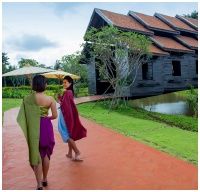 |
| |
| Saphan Han (Turnable bridge) |
| Named by its shape. In the past, it was a single sheet of wood laid across the canal. One end tied tightly to the bank, the other let loose. This way, it can be moved (or turned) allowing boats to pass through. In the reign of King Rama IV, it was rebuilt as with steel frame and wooden floor. Until, King Rama V changed it to the Venice’s Rialto or Florence’s Ponte Vecchio style which is a wide arch bridge with small shops on both sides, leaving the space in the middle for passersby. His Majesty loved visiting this bridge to buy imported dried fruits such as dried plum. |
| |
| Ancient Market Zone |
| In R.E.124, there were several market zones that were considered famous and modern for the era. They are Prange (Intersection) zone, divided into three sections (Prange Nara, Prange Phuthorn, and Prange Sappasart), Yaowarat zone and Bangrak zone. |
| |
| The Prange Nara Road Zone, the road's name comes from the name of HRH Prince Narathipprapanpong whose name at birth was HRH Prince Worawanasakorn, the origin of the royal family surname Worawan Na Ayutthaya. He was a son of King Mongkut (King Rama IV) and the Royal Concubine Kean. He served in the Department of Treasury as the deputy chief. He resided at the palace where his father, the King, built on Tanao road. Its territory connected to the Palace of HRH Prince Thaweethawalai. While residing at this palace, he built the first theater in Thailand called Pridalai Theater. At that time, it was assumed that he requested to build a road cutting through the middle of his palace, and built two commercial building blocks. Thus, people call the street by the name of the palace's owner, "Prange Nara Road" |
| |
| Prange Phutorn Road received its name from the name of HRH Prince ThaweeThawalai (later named as HRH Prince PhutornThamrongsak), the origin of the royal family surname Thaweewong. He was the son of King Mongkut and the royal concubine Talab. He served as Commander in Chief of Metropolitan Ministry. His residence was at the corner of Si Kak Sao Ching Cha intersection, on Baan Tanao Road. After his death in 1894, the palace was sold to King Rama V. His Majesty graciously ordered the build of a townhouse and cut a road through the palace, named after the former owner, Prange Phutorn. |
| |
| Prange Sappasart Road received its name from HRH Prince Thongtamtawanlayawong (later named as HRH Prince Sappasarttrasupakit), the origin of the royal family surname Thongtam. He was a son of King Mongkut and royal concubine Sangwan. He served as royal page, chief of department. He resided at the palace on Baan Tanao Road next to that of HRH Prince NarathipPrapanpong. After his death, his heir sold the palace area to private. The palace itself was demolished to construct commercial buildings and the road that cut through the palace was named after the former owner, Prange Sappasart. |
| |
| Bangrak is a major commercial district with many modern shops. In Yaowarat area, where the Overseas Chinese live and living. |
| |
| City Tower |
| It was simulated from the prison tower which was built to create an elevated observation point for supervising and preventing prisoner escapes. It is nowadays used as a scenery point of the Mallika city. |
| |
| Reuan Dieow |
| It is a detached house for commoner. People living in this type of house were mostly proletariats whose duty was to produce basic living needs such as farming for rice, vegetable and other plantation, weaving, and clothing; all the common occupations of this social class. This type of house in the Mallika shows commoners’ ways of life in R.E.124. |
| |
| Reuan Khaha Bodi |
| It is for the rich. Inside Reuan Khahabodi displays lifestyle of ruling class, including various activities such as fruit & vegetable craving, flower & banana leaf decoration, and etc. All products are actually used and sold in the Mallika city. In the area of Reaun Khahabodi, there is its supplement part, “Reuan Krua”, Traditional Thai Kitchen to provide food for all residents and guests. |
| |
| Cooking Kitchen |
| Includes rice production house, barn house, and preparing kitchen. It shows the process of rice winnowing, rice milling, rice pounding, and rice cooking by using a large frying pan. In that period, the cooks/housekeepers had to cook food and dessert for many servants and guests by using a charcoal stove. |
| |
| Reuan Pae Floating House |
| During that time, the most common mean to transport was by the river. Shop houses, thus, located on the river banks. There were also Ruen Pae or floating houses for trading or as caf?. Tonghoo, the most modern caf? of the era with its imported coffee beans, used its Ruen Pae to accommodate travelers. Its food earned the reputation as the King’s favorite. Mallika city displays the King’s dishes to demonstrate the simplicity and deliciousness of the true Thai food. |
| |
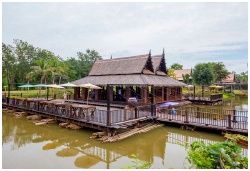 |
| |
| Reuan Hmoo |
| It was used by the rich as a visitor reception. Wealthy Thai people could include high ranking officers or rich merchants. To own Thai traditional dance team to perform for their important visitors was also a popular idea among noblemen then. Mallika City has the largest Reuan Hmoo in Thailand. It displays the living condition of these traditional Thai dancing team; their activities during day and night. When visitors come for dinner, the show is on; the food is served, authentically and neatly displayed with ancient wisdom. We will see some old dishes such as Gangbuan, a thick soup with herbs and entrails. |
| |
| Jasmine Garden |
| Mallika, by Thai dictionary, means Jasmine. There are more than a hundred species of jasmine in Thailand that are unknown to newer generations. Mallika city, then, built a jasmine garden collecting various kinds of jasmine for your eyes and noses. |
| |
| |
| Admission Fee |
| |
| One day pass ticket |
| |
| Adults |
250 |
THB |
| Seniors |
120 |
THB |
| |
|
|
| Children |
120 |
THB |
| |
|
|
| |
| One day pass ticket + dinner and performance |
| |
| Adults |
700 |
THB |
| Seniors |
350 |
THB |
| |
|
|
| Children |
350 |
THB |
| |
|
|
| |
| * Children under 100 cm, free of charge / 101 – 130 cm, children price / Seniors over 70 years old. |
| |
| Dinner Opens daily at Reuan Hmoo, from 18.00 to 20.00 hrs. Advance reservation is required, please call: 034 540884–86 |
|
* The price includes rice, fruit, and drinking water. All food will be refilled.
|
| |
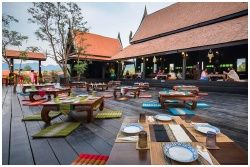 |
| |
| Dinner Menu |
| Consists of crispy noodle, entrails soup, chili paste with fish, spicy mixed salad, Mussaman curry. Choice of menu is carefully selected for new generations to savor authentic taste of the dish crafted by Thai ancestors' wisdom. These dishes are hardly found nowadays or they have already been much modified. |
| Gang Buan (entrails soup): when speaking of entrails soup, many will think about its fishy smell. But, with the wisdom of the Thai ancestors, it can be eaten in the absence of the scent. Using herbs, roasted and grounded as main recipe, cooked with pork entrails. The cooking process is very complicated so most people do not know about it as only handful of people can cook it. |
| Crispy noodle: the food has been adapted since then till present day. When mention crispy noodle, younger generation will think about fried flossy noodle mixed with various ingredients and molded into a ball-like shape, can be kept for quite a long time. However, original crispy noodle is not flossy but white and scented with bitter orange, not very sweet, rather rounded taste, but cannot be kept for long. There are also chili paste with fish, chicken Mussaman curry and spicy mixed salad. |
| |
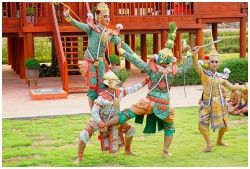 |
| |
| SHOWS |
| Duration 1 hour, start at 19.00 hrs. |
| |
| Khon (classical Thai pantomime) |
| Battle of Ravana and Rama (The Battle). This show is a part of Ramayana, a play based on a story of a war between Rama, Lakshmana and their monkey army with Ravana, a demon King of Lanka city. The battle of the two is full of incredible dance moves, battling acts; a unique and exquisite art. |
| |
| Pirompatchanee Dancing |
| Malika City's Theatrical Art Department was inspired by the dress and manner of ladies in R.E 124. So, they invented beautiful dance moves, and chose the song that matches the atmosphere of R.E 124 to fit and suit the dance. The elegance of R.E 124 ladies was conveyed to the music of joy which is the name of this show, Pirompatchanee, lady of joy. |
| |
| Puppeteer |
| The puppetry art based on royal puppet and other kinds of local puppetry for various region including other performance and traditional dancing. It is a combination of puppetry, shadowy play as well as international art show, along with a unique style of an actor to perform each act. |
| |
| Gliding Ginnaree |
| This show puts together two performances to make it more interesting. It is praised for its distinguished dance moves and costumes. The first show is Gliding Ginnaree, a scene where Manohra and her sisters, Ginnaree, fly down to Anodas pool of Krailas mountain. The other show is Manohra Dance by Khunying Paew Sanitwongseni who invented the dance move. The Sacrifice of Manohra is a dance of the Ginnaree, Manohra, pretending to sacrifice herself into fire before flying away in escape. |
| |
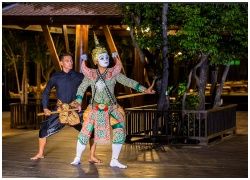 |
| |
| Satchatri |
|
This show is popular for its uniqueness southern style. Developed from Sat dancing, a dance tribute to art masters of Chatri performance which is one of Thai classical stage show considered an origin of many other performance born in later era. According to Chatri tradition, the actor must perform a prelude in worship of the art masters called "Sat dance" to the rhythm of various Thai music instruments. Later on, the Department of Fine Arts has adapted the dance to have both the male and female performers to make it look more lively but keeping the tempo unchanged. The point worth noticing is a well-defined; synchronize set of movements to the beat. While the dancers are performing, drummers urged the rhythm in harmony. This is why it is so popular among the audiences.
|
| |
| Font Pan |
| It is presumed to have originated from the theatrical tale of Pra Lor, a play written by HRH Prince Narathip Prapongpong. This is the chapter when the main character, Pra Lor, takes a bath in Kalong River. The dance moves are made up of northern style mixed with Thai dance and are adjusted to the melody. Originally, Pan Dance was a solo dancing. Later, Ms. Lamun Yamakup added more moves and performers; changed to a group dance, male or female. The lyrics were composed by Major General Luang Vijitwatakan. The first show was performed by Department of Orchestral, Silpakorn School (now the College of Dramatic Arts) in the occasion of Art and Culture exhibition in Japan. There are two types of lyrics, full and cut. However, it is performed without lyrics nowadays. |
| |
| Sword Play |
| Sword play is one of basic elements of Thai martial arts. The name Sword Play derived from the fact that this sport brings martial arts and armed weapons techniques used in battle in ancient times and to practice and play in peaceful era. As a sport, rattan is used to make these armories, swords, halberd etc. Leather is made into shields. Then, fighters are paired up to play or compete against each other the same way as on the battlefield, practicing both attack and defend technique. |
| |
| Laos Kratob Mai |
|
Kratob Mai is a native play of Surin province, formerly known as Sak Dance. Thailand has a long history of agriculture. Rice farming is the mainstay of Thai people, making a lot of income as export product. Daily life of Thai people, hence, engaged with rice farming. From sowing, plowing, planting and harvesting, etc. and with a fun loving habit, after work, the farmers pound their rice pestles giving beat to this traditional games. Originally, the beat may come from the pace of rice pounding when two people take turn in using the standing mortar. Later on, develop into using long pieces of wood with a short piece of wood on each end, the performers knock these four pieces of wood in a rhythm.
|
| |
| |
| SERVICES |
| Mallika City, 1905 A.D. : เมืองมัลลิกา ร.ศ.124 กาญจนบุรี |
| |
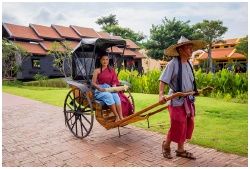 |
| |
| Rickshaw |
| Rickshaw or so-called buggy was mostly provided by Chinese immigrants who lived under the royal protection of King Rama V. The service charge is 50 Baht per ride and the ticket is available for sale at the front of the city. |
| |
| Traditional Thai Costume. |
| Women |
| 200 THB : breast cloth, loincloth, belt, accessories and an umbrella. |
|
300 THB : blouse with decoration cloth, loincloth, belt, accessories and an umbrella.
|
| |
| Men |
| 100 THB : Chinese jacket, loincloth and Sash. |
| 300 THB : Raj Pattern shirt and loincloth. |
| |
| Children |
|
50 THB : round-necked sleeveless blouse and loincloth for girls, Chinese jacket and loincloth for boys.
|
| |
| Note: Prices are subject to change. |
| |
| Holed Coins / Coins with Holes |
|
An ancient currency of both Ayutthaya and Sukhothai eras; it is also used as a medium to exchange goods and services in the city of Mallika.
|
| Exchange rate: 1 Satang = 5 Baht |
| |
| |
| www.centerresort.com |